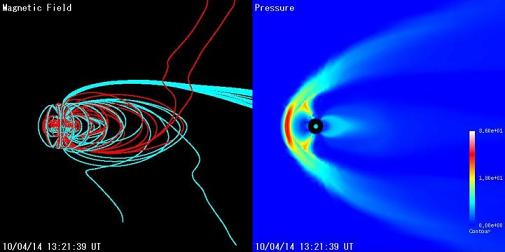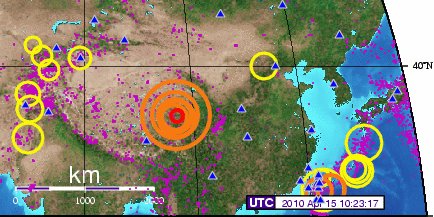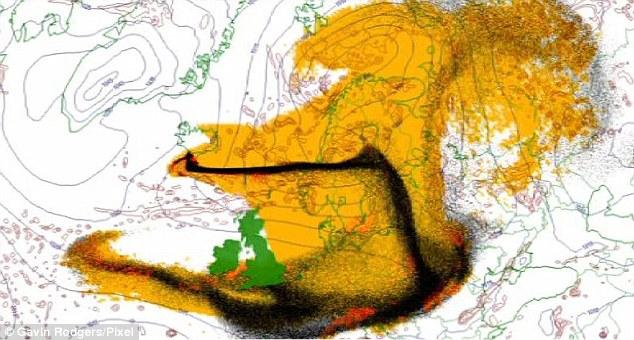Coral Sea Rise
Two tsunami buoys near the Australian coast in the Coral Sea gave alarms during early April, recording
a rise in the ocean floor beneath them. The agency in charge of the buoys finally announced that one of
the buoys, #55023, must be defective and would be replaced, and cleared the data from public view.
However, more than one buoy was involved in the alarm, both recording the same readings. Buoy
#55012 likewise recorded a drop in the distance between the surface and the ocean floor. The rise was
dramatic. A GodlikeProduction thread started intense discussion on the issue.
Has a Tsunami station in event mode activated for Station 55023 - STB Coral Sea
located at 14.803 S 153.585 E? The tsunami station has been in event mode since
the large quakes occurred in the area for several days now. This is triggered by
the buoys' anomalies of water column height above the sea floor. If you do a data
search for 2010 March 20th to 2010 April 13th you get this - over 100 meters or
328 feet less distance from buoy to sea floor in 24 days! That's 13 feet per day
since the quakes. As you will see from the waves on the line graph it matches the
tide lines perfectly.

SOURCE: http://www.tide-forecast.com/locations/CatoIsland-CoralSea/tides/latest
The next nearest buoy is over 500 km away and has not been showing data since
17 March 2010. However from the 16 March to 17 March its water level dropped
39 metres. Is this just a coincidence?
There are no active volcanoes in the Coral Sea area, undersea or above sea level. The buoy in question
rode above the deep trench just north of the Coral Sea Islands.

And as one can see this area just to the west of the Vanuatu Islands is on the eastern edge of the
Indo-Australian Plate. This area, Vanuatu, has been experiencing puzzling volcanic activity, and this part
of the globe is very seismically active.

Then we have what is going on at the opposite side of the Indo-Australia Plate, where islands off the
coast of Bangladesh are sinking.
- Disputed Island Disappears Under Rising Sea.
March 24, 2010
http://www.csmonitor.com/World/Asia-South-Central/2010/0324/
- An island disputed by both India and Bangladesh has been claimed instead by the ocean,
marking a rare instance where suspected climate change may contribute to the easing of a
conflict. What the Indians call New Moore island and the Bangladeshis call South Talpatti
lies in the Bay of Bengal, a region with large potential reserves of gas and oil. Satellite
imagery shows the island now submerged.
What do the Zetas have to say about this rising and falling land along the Indo-Australian Plate?
ZetaTalk Explanation 4/17/2010: We have stated, since the start of ZetaTalk in 1995, that during
the pole shift the eastern side of the Indo-Australian Plate will rise while the western side plunges
under the Himalayas at India. Of course, this is the steady pace as the plates begin to loosen up
and move. In the holographic presentation Nancy attended in November, 2009 she was warned
that additional tipping of the plate will occur. The Indo-Australian Plate will tip sideways so that
Indonesia can plunge under the eastern side of the plate. Islands in Indonesia will be affected by
this plunge, ultimately sinking. Do such adjustments happen all at once, or gradually? Both
occur, but the trend is unmistakable long before a major adjustment occurs. If one side of a plate
is rising, and the other dropping, will this be uniform, such that the entire edge of the plate rises
or falls? Where Earth plates share rock layers that tend to move as one, there is never
uniformity. What is seen from above are mountains and valleys, and what could be seen from
below are similar. The plates are thick in places and thin in others. We have mentioned that
rivers flow along places where the plates are thin, and thus have dropped due to lack of support.
This is likewise true of ocean trenches. When a plate is rising due either to subduction by another
plate or a tipping action, pressure on one end of the plate causing the other end to rise, what
occurs? The plate will tend to rise as one but will sag where the weight of the plate can draw the
rock layers down. However, this sagging will not occur where the rock strata is strong. Thus, an
uneven rise will be observed. Sagging can cause the the thin area to rise if the heavy rock on one
edge bends down, as the thin spot is lightweight relative to the heavy rock that has dropped.
China Hammered
On April 14 the Earth's magnetosphere lost its S Pole again, along with a noted lean to the left on April
12-14, and right on schedule major Earth changes occurred. This correlation was noted in Issue 181 of
this newsletter. The Earth changes included the earthquake hammering that China experienced where the
Indo-Australian Plate is being shoved under the Himalayas and the spreading of the Atlantic at Iceland.

The Tibetan Plateau was hammered so fiercely that he area turned red on the IRIS charts - a 7.1 quake
followed within five major aftershocks within 12 hours. As usual, the USGS downplayed the magnitude,
placing it at 6.9 so statistically it could not be considered a 7+. The death toll, as with all China quakes,
was horrific.

- What Was Different About China's Quake?
April 14, 2010
http://www.livescience.com/environment/china-quake-tibetan-plateau-100414.html
- The earthquake that struck China in the early hours of the morning occurred in the middle
of one of Earth's tectonic plates, instead of at the junction between them. This area is part
of the Tibetan Plateau, which stands over 3 miles above sea level. The Tibetan Plateau
was created, along with the Himalayas, about 50 million years ago as part of the Indian
subcontinent began to collide with Eurasia. The plateau, where the recent quake occurred,
experiences continued uplift from the processes that originally created it, and is also being
squeezed by other forces, which create numerous faults in the area. Exactly what fault
ruptured in this quake isn't yet known.
-
- China Earthquake: Death Toll Could Reach 10,000
April 16, 2010
http://www.telegraph.co.uk/news/worldnews/asia/china/7597627/
- The death toll from the 7.1 magnitude earthquake that hit western China's remote Tibetan
plateau will rise dramatically and could reach 10,000. The official death toll now stands at
1,144, with a further 243 missing and 1,174 severely injured. However, monks at Jiegu
monastery said at least 1,000 corpses had arrived at their temple alone, and that four
other monasteries had each collected a similar number.
Iceland Volcanoes
In step with the hammering on the Tibetan Plateau on April 13-14, which accompanied the loss of the
Earth's S Pole on the magnetosphere, the volcanoes on Iceland indicated that new spreading of the
Atlantic has occurred. Eyjafjallajökull, which had rumbled to life in March, 2010 exploded, creating a
horrific ash cloud that engulfed Europe. The ash cloud sweeps across Norway and Sweden, and then
curls south to cross the UK and north toward Poland. This caused the largest airline shutdown since
World War II in Europe. The larger worry is how long this eruption will last.

- All UK Airports Closed Due To Volcano Ash
April 15, 2010
http://news.sky.com/skynews/Home/UK-News/Iceland-Volcano-Grounds-UK-Flights
- All UK airports - including Gatwick and Heathrow - have been closed after a massive
cloud of ash from a volcano in Iceland drifted into UK airspace. Air space in Scandinavian
countries including Denmark and Norway has also been closed.
-
- Icelandic Eruptions May Disrupt Air Travel for Months
April 17, 2010
http://www.bloomberg.com/apps/news?pid=20601087&sid=aWhdMivcLsNg
- Eyjafjallajökull last erupted in December 1821, with the event lasting until January 1823.
The current blast has sent ash to as high as 7 kilometers (4.5 miles), according to a
vulcanologist at the University of Iceland. The edge of the ash cloud was forecast to reach
as far south as northern Italy and Romania and as far east as the borders of Kazakhstan.
More than business interests related to airline travel and the ability to import food into Europe are at
stake. Volcanic ash can worsen asthma, and in the worst case settle into the lungs like liquid concrete.
Crops can be affected by the volcanic gloom, and livestock poisoned by fluoride and other metals in the
ash.
- Ash Fall in Iceland Could Contaminate Drinking Water: Experts
Apr 16, 2010
http://www.breitbart.com/article.php?
- The fallout of volcanic ash over parts of Iceland could jeopardise the safety of drinking
water. The greatest health risk was to livestock. The blast mostly posed a health risk to
livestock because the ash contained high levels of fluoride.
-
- Doctor: Volcanic Dust Cloud Increases Risk of Death
April 16, 2010
http://www.foxnews.com/story/0,2933,591164,00.html?test=latestnews
- The World Health Organization issued a warning to Europeans Friday to stay indoors as
ash from Iceland's volcano starts settling. Small amounts of ash have already begun to fall
in Iceland, Scotland and Norway. Concern is growing about the potentially deadly health
effects the ash could have on people living in the region. The enormous dust cloud may
contain large amounts of silica, a natural component of rock that comes with these types
of volcanic explosions. Silicosis is an incurable, irreversible lung disease that progresses
even after exposure has ended. History shows just how harmful silica in the air can be. In
the 1980 eruption of Mount St. Helens in Washington, people in the region reported pink
eye and irritation, chronic stuffy noses, scratchy throats, coughs and chest tightness.
The Zetas were asked about the significance of this latest eruption, how long it would continue, and how
much grief this would cause for Europe.
ZetaTalk Comment 4/17/2010: Iceland hosts many volcanoes as it sits on the boundary between
the great Eurasian Plate and the great N American Plate, which are spreading apart. The tearing
of the Atlantic Rift has been predicted by ourselves to occur long before the pole shift, and is
already occurring. This is just the start. Without question, Iceland's volcanoes will be highly
active from this point forward, with only temporary periods where the ash seems to abate.
Iceland may be leading the pack, but volcanoes on the West Coast of the Americas, the Andes,
and in Indonesia and elsewhere will follow suit. The dangers from volcanic dust are well known,
no secret, and one of the main reasons we have warned that drinking water should be distilled
after the pole shift. Will crops be affected in Europe and elsewhere? Without question, just as
they have been affected by weather extremes since Planet X arrived in the vicinity.
Iceland's volcanoes are along the rip, the stretch zone between the great Eurasian Plate and the great
North American Plate. When Eyjafjallajökull last erupted in December 1821 the event lasted until
January 1823. The concerns are that a sister volcanoe, Katla, will blow, with Icelandic scientists now
indicating a 75% chance that this will occur. Historically, when Eyjafjallajökull erupts, Katla follows.

- Iceland's Eyjafjallajökull Volcano is Nothing to 'Angry Sister' Katla
April 18, 2010
http://www.csmonitor.com/Science/2010/0418/
- The last time Eyjafjallajökull erupted, it continued belching the Earth's unsettled insides
for 14 months, from December 1821 to January 1823. The three times in recorded history
when Eyjafjallajökull has erupted, its neighbor, the much larger Katla, has followed suit.
On 1783, one-quarter of Iceland's population was killed when Laki erupted - an eruption so
massive that it changed global weather patterns, bringing record snow to New Jersey and
drought to Egypt.
The amount of volcanic ash that could be released into the atmosphere from Iceland's volcanoes,
potentially, has many holding their breath. The eruption of Laki in 1784 has not been forgotten.
- Laki Consequences in Europe
http://en.wikipedia.org/wiki/Laki
- The outpouring of sulfur dioxide during unusual weather conditions caused a thick haze to
spread across western Europe, resulting in many thousands of deaths throughout 1783 and
the winter of 1784. The poisonous cloud drifted to Bergen in Norway, then spread to
Prague in the Province of Bohemia, Berlin, Paris, Le Havre, and to Great Britain. Inhaling
sulfur dioxide gas causes victims to choke as their internal soft tissue swells. It has been
estimated that 23,000 British people died from the poisoning. The extreme winter is
estimated to have caused 8,000 additional deaths in the UK.
You received this Newsletter because you Subscribed to the ZetaTalk Newsletter service. If undesired, you can quickly
Unsubscribe. You can always access prior Newsletters from the Archives.
|

